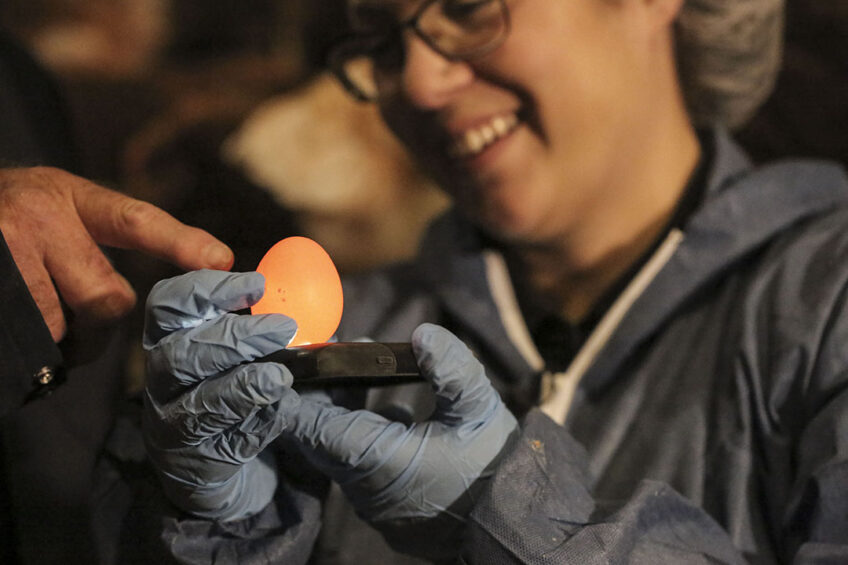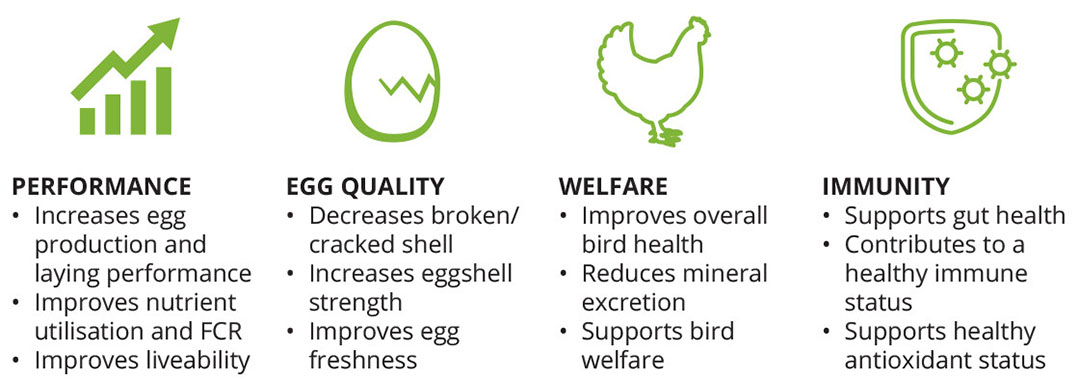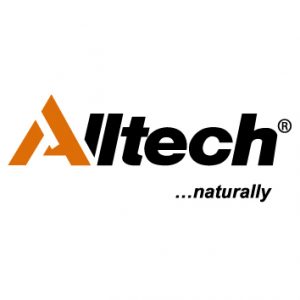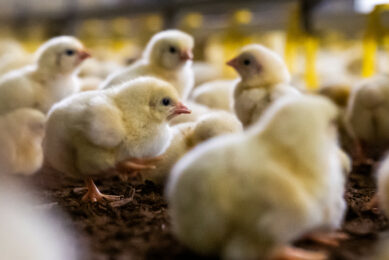Optimal performance relies on good nutrition and gut health

Profitable poultry production depends on many factors and has become more challenging with surging production costs. Some of the pressure has been alleviated by a corresponding rise in egg prices, but with other costs increasing, focusing on the birds’ nutrition and gut health to maximise performance is still paramount.
Combining gut health and organic mineral technologies allows each bird to get the most out of its feed and achieve its potential, with enhanced overall health, better performance and even stronger shells. Historically standard poultry diets have contained inorganic sources of minerals such as copper sulphate and zinc oxide to meet the birds’ requirement for minerals to maintain normal bodily functions and produce eggs. However, minerals from inorganic sources, which are reactive in the premix and in the gastrointestinal tract, result in low bioavailability.
Figure 1 – Yeast mannan-rich fraction leads to better performance, egg production and quality, welfare and immunity.

This is why inorganic minerals’ inclusion levels are higher in the premix to overcome low bioavailability and result in high levels of excretion. The interactions of inorganic minerals with other feed components include binding to other minerals, binding to vitamins, interfering with enzymes, affecting their efficacy, and acting as pro-oxidants, which can cause oxidative stress in the gut.
Vitamin binding: Some inorganic trace minerals bind to vitamins contained in the diet, making those vitamins unavailable to the bird and causing high rates of vitamin degradation and loss within a premix.
Mineral binding: Inorganic forms of minerals such as ZnSO4 and CuSO4 often bind to each other. When this happens, they tend to “lock up,” making them unavailable to the bird. This is why typically higher levels of inorganic minerals are added to diets in an attempt to compensate for the amount of minerals unavailable to the bird, thus ensuring that their requirements are met.
Enzyme interaction: Phytase enzymes are added to most poultry diets to release phosphorus from phytate, making it available for the bird. High levels of some minerals in the birds diet can inhibit phytase, while proteinate minerals such as Bioplex have a lower inhibitory effect on phytase. Inorganic trace minerals (ITMs) can also bind to diet components such as phytic acid, rendering both the inorganic mineral supplemented and the phosphorus bound to the phytate molecule unusable by the animal.
Antioxidant inhibition: Inorganic minerals can inhibit antioxidants and have a high pro-oxidant potential. Pro-oxidants cause oxidative stress in the gut, which can inhibit gut health and damage the integrity of the gastrointestinal tract, reducing nutrient digestion and absorption and therefore feed efficiency.
Benefits of organic minerals
Organic minerals are in many ways more suitable, but not all organic minerals are equal. Which organic material the mineral is bound to is very important. The bond must be stable enough to hold through absorption, even at a low pH. The organic minerals in Alltech’s Bioplex are bound organically to amino acids and a range of peptides, making them proteinates. This means they can help the mineral get all the way from the premix through the GI tract to the site of absorption. Proteinate minerals also have lower inhibitory effects on essential enzymes. The types of organic minerals included in Bioplex also have high bioavailability, so lower levels can be included in feed and less will be excreted. This means that Alltech’s Total Replacement Technology (TRT) can be used, which involves removing inorganic minerals and replacing them with lower organic minerals. This removes the negative interaction from the inorganic minerals, leading to better performance and higher eggshell strength. In addition, feeding organic minerals in the form of Bioplex at lower inclusion levels has also been shown to reduce the amount of mineral waste in the litter, reducing environmental impacts.
Optimal performance
Even providing the best raw feed materials and nutrition doesn’t guarantee performance. No matter how good the bird’s diet is, if its gut health isn’t optimal, it will not get the full benefit. If a hen cannot digest and absorb the nutrients she eats, they will pass through her, go to waste, and even harm the environment through excretion. It is critical for layers to have the right minerals available to them and good gut health so that they can absorb and utilise the diet and thus produce strong consistent eggs for longer. Bad gut health can result in thin eggshells that crack easier, increasing levels of seconds and rejects.
Why is a healthy gut important?
A diverse gut microbiome acts as a protective barrier that inhibits colonisation by pathogens from the environment, feed or water.
Much of a bird’s immune system is in the gut, so keeping the immune system strong and reducing unnecessary inflammation is important for good performance.
A healthy gut will have good integrity – i.e., a large surface area with good, tight junctions – to further block pathogens and help the bird absorb nutrients fully and efficiently.
The yeast mannan-rich fraction (MRF), derived from Saccharomyces cerevisiae has proven to be effective in maintaining these three main aspects of gut health, leading to better performance, higher egg production and quality, welfare and immunity.
Visualisation of improvements
At Alltech, we believe that “seeing is believing,” so a tool was developed for assessing the quality of the eggs being laid in a production system. When eggshell quality is made measurable, reportable and verifiable, producers can truly assess the effects of any change they make. After collecting and analysing data from 16 million birds from 14 different layer breeds and production systems, researchers were able to demonstrate significant benefits for productions using Alltech layer solutions. The graph below shows an improvement in eggshell strength from an average of 4.47kgF to 4.87kgF, with less variance of results.
Focusing on improving layer gut health and mineral management in a measurable way will lead to improvements in the bird’s ability to digest and absorb nutrients and ultimately increase feed efficiency and performance. This will help the poultry production system to become more economically and environmentally sustainable.











